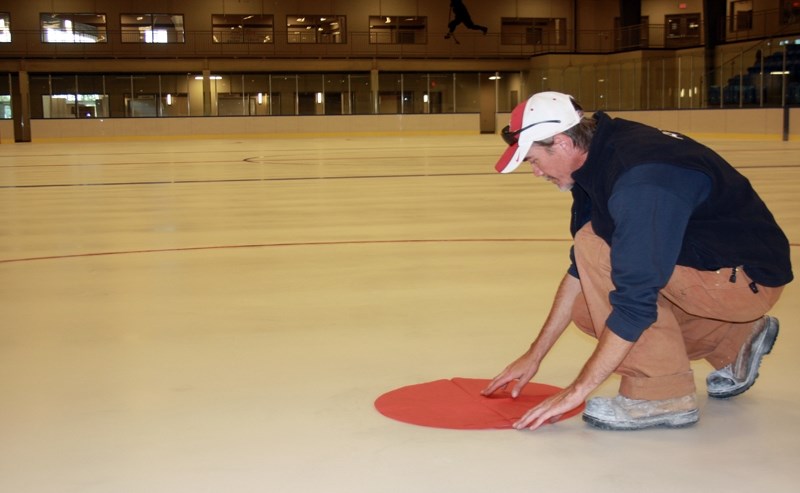It seems so simple when you watch a Zamboni make its rounds across the ice surface, but few people realize how much time and effort goes into creating the perfect ice surface for winter sports.
There’s a lot more to it than simply turning on the hose and flooding the arena; it’s a painstaking process that can last weeks, especially with a new facility like the Westlock Rotary Spirit Centre.
Brian Hennessey, a facility operator at the new arena, said work began in late August with a mechanical contractor starting up the ice plant for the first time and making sure everything was working properly before the ice-making even began.
“It’s all normal issues with the first time running a plant,” he said. “They didn’t want us to get to a certain degree of (the ice) being complete and then losing it.”
Once the concrete pad had been slowly cooled — in increments of two degrees Celsius per day — town staff began to build up the ice beginning Sept. 7.
Vicky Longstreet, the former facility operator coordinator, said that can be where the real challenge begins. The ice must be pebbled, meaning droplets are sprayed across the surface of the concrete and allowed to freeze before more droplets are sprayed. The process is repeated several times to get the base.
It’s a slow process, and it takes so much time because of how important it is to get a good air-free base before the colour starts to go in.
“You put it on in millimetres for the first five or six times out,” Hennessey said. “It goes on very thin with no air — that’s so important.”
Once the first quarter inch of ice is there, the entire surface is painted white. At that point, the process begins all over again, painstakingly sealing in that coat of paint without melting through it.
“You’ve got 10 seconds for that hose to burn through the ice anywhere,” Hennessey said. “You’ve got to keep that hose moving.”
When the next quarter inch of ice is in, then it’s time to put down the lines, face-off points, circles and creases. These aren’t painted on, but rather are made of tissue paper that is carefully placed on the ice then sealed in.
Precision is key for this part of the process — lines should be accurate to within one sixteenth of an inch, or about 1.5 mm.
“You should be able to take our rink and set it on top of somebody else’s and it should be just about bang-on,” Longstreet said, notwithstanding variations in the size of each arena.
Once the lines are sealed in, the ice is built up using hot water in very thin layers, repeated several times. Hot water is used instead of cold water, since that ensures each layer of ice freezes from the bottom up, thereby preventing air pockets from forming.
Ice should be at least one inch thick before people are skating on it; any less than that and there are some potential safety hazards at play. On the other hand, if it gets to be more than an inch and a half thick, the quality of the ice itself tends to suffer.
Of course once the ice is at the ideal thickness, it’s not just a matter of running a Zamboni over it every so often. Regular maintenance must be done to ensure the consistency of the ice surface.
Without that maintenance a lip can form around the boards, and the goalie creases can get divots. Temperature and humidity must also be carefully monitored, especially for events with a big crowd.
“It can also depend on the size of the crowd you have,” Hennessey said. “Once we get a tournament in here with 400 people, you get a lot of different things that can affect the ice.”
With three facility operators on staff, however, all trained through the Alberta Association of Recreational Facility Personnel, the arena is in good hands.
Judging by the hundreds of people milling about the Spirit Centre last Sunday afternoon for the free skate from 2-4 p.m., there is a lot of excitement about this winter skating season.
Kestyn Dutchak, 12, said the new arena is way better than the old one, especially with the seating going all around the arena instead of just off to one side.
“It’s really good, and the ice is good,” he said.
The off-ice parts of the new arena also impressed him.
“The penalty boxes and benches are way bigger, and the dressing rooms are huge,” he said.
Clem Fagnan, who has a vested interest in this facility by virtue of not just his position on town council but his long-time involvement with the Westlock & District Minor Hockey Association, said he was happy to finally get out on the ice with the rest of the community.
“I think it’s great; there are 150 people out here,” he said.
Part of the success of the facility, despite the nay-sayers throughout the process, is the fact so many community members were supportive in the planning phase and continued to be supportive right up to the first ice time.
“We’ve got figure skating, we’ve got hockey, we have the young, we have the old,” he said. “I think everybody’s really happy.”



